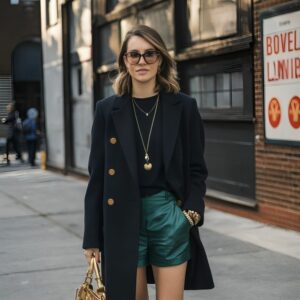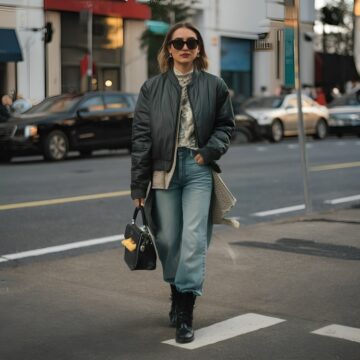Finding Your Personal Style
Embrace Self-Discovery
Finding your personal style is an exciting journey of self-discovery. Start by understanding yourself – what makes you feel confident, and how your values and personality can be reflected through your clothing choices. This process takes time, so be patient and open to experimentation.
Curate Your Inspiration
Create a visual roadmap for your style evolution. Use platforms like Pinterest and Instagram to build mood boards filled with outfits and looks that resonate with you. Analyze these collections to identify common themes, colors, and silhouettes that appeal to you most.
Build a Versatile Foundation
Start with a wardrobe of versatile basics that align with your emerging style. Choose a color palette that flatters your skin tone and overall aesthetic. Invest in quality pieces that can be mixed and matched easily, creating a cohesive and functional wardrobe.
Experiment and Refine
Don’t be afraid to step outside your comfort zone. Try new silhouettes, colors, or trends to discover what truly resonates with you. Remember, personal style is fluid – it’s okay for your preferences to evolve over time. Forget about fashion “rules” and focus on what makes you feel authentic and confident.
Cultivate a Signature Look
As you refine your style, identify key pieces that become your signature. These could be accessories, specific cuts of clothing, or color combinations that you consistently gravitate towards. Your signature look should make you feel uniquely you, setting you apart while staying true to your personal aesthetic.
Understanding Different Fashion Styles
Fashion is a diverse and ever-evolving world, offering a myriad of styles to explore. To develop your unique personal style, it’s crucial to familiarize yourself with various fashion aesthetics and understand how they resonate with you.
Become an Expert Observer
Start by becoming an expert observer of fashion around you. Pay close attention to how others put together outfits, noting details like color combinations, silhouettes, and accessory choices. This keen observation will help train your eye and develop your fashion sense.
Explore and Experiment
Venture beyond your comfort zone without fear. Actively seek out new styles, colors, and silhouettes that differ from your usual preferences. This experimentation phase is crucial for discovering what truly resonates with you. Try replicating looks you admire from fashion blogs or Pinterest using your own clothes, then assess what you like or dislike about each outfit.
Identify Your Core Pieces
Take a closer look at your most-worn, favorite pieces. These items can serve as a starting point for developing your personal style. Analyze what you love about them – whether it’s the fabric, fit, or specific details. Use these insights as a guide when shopping to build on your existing wardrobe and create a cohesive look that feels authentically you.
Recall that developing your own style is a continuous process.. Embrace the journey of exploration and discovery, and don’t worry about defining your style immediately. Focus on understanding what you’re naturally drawn to and what makes you feel confident and empowered.
Creating Outfits That Reflect Your Personality
Express Your True Self
Fashion is a powerful form of visual communication that allows you to convey messages about your personality, identity, and values. The key is to project an attitude and confidence that aligns with your authentic self. Start by identifying your style essence – the core of your true personality and preferences. This could be feminine, creative, elegant, rebellious, or a combination of different essences. Once you’ve pinpointed your essence, aim to create a balanced and genuine style expression through your clothing choices.
Experiment with Colors and Patterns
Don’t be afraid to incorporate colors and patterns that resonate with your personality. Bright, vivid hues can reflect an outgoing nature, while softer tones might indicate a more sophisticated demeanor. If you’re drawn to loud colors but hesitant to wear them, start small by incorporating colorful accessories into your outfits.
Incorporate Personal Touches
Make your outfits uniquely yours by adding elements that reflect your interests, hobbies, or values. This could mean wearing band t-shirts if you’re a music enthusiast or incorporating sustainable fashion pieces if environmental consciousness is important to you. Remember, the goal is to present a style that feels authentic and comfortable to you, while still being adaptable to different occasions and environments.
Developing Your Unique Fashion Aesthetic
Embrace Your Personal Preferences
Developing your unique fashion aesthetic is a journey of self-discovery and expression. Instead of blindly following trends, focus on pieces that genuinely resonate with you. Take time to explore different styles without the pressure to buy, allowing yourself to identify what truly speaks to your personality. Create mood boards on Pinterest or Instagram to visualize your ideal aesthetic and save outfits that inspire you.
Experiment and Evolve
Don’t be afraid to step outside your comfort zone. Try new silhouettes and styles, even if they don’t immediately feel like “you.” This experimentation is crucial for growth and can lead to unexpected discoveries about your preferences. Remember, Developing Unique Fashion your style is an ongoing process that evolves over time.
Build a Cohesive Wardrobe
Invest in timeless neutral pieces that can be paired with accent colors and will stand the test of time. A classic trench coat, blazer, or well-fitted shirt can serve as the foundation of your wardrobe. Identify your core staples and build outfits around them to create a signature look that’s uniquely yours. Aim for a wardrobe where you love and wear everything, rather than accumulating unused clothes.

[…] include fabric scissors, a sewing machine (or needle and thread for hand-sewing), measuring tape, fabric chalk or markers, and an iron. As you progress, you might want to invest in a seam ripper, pinking […]